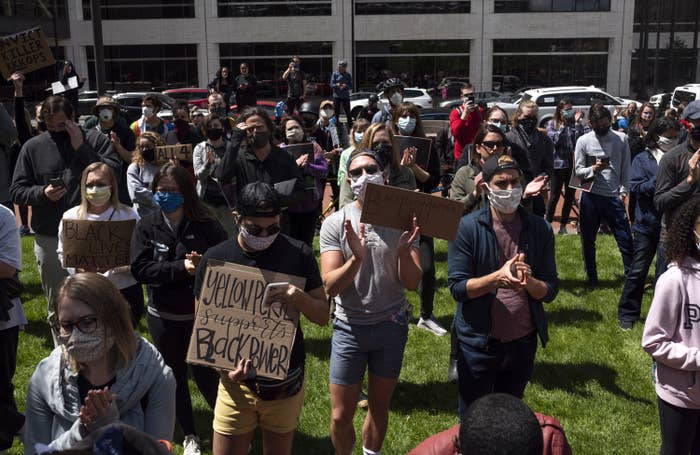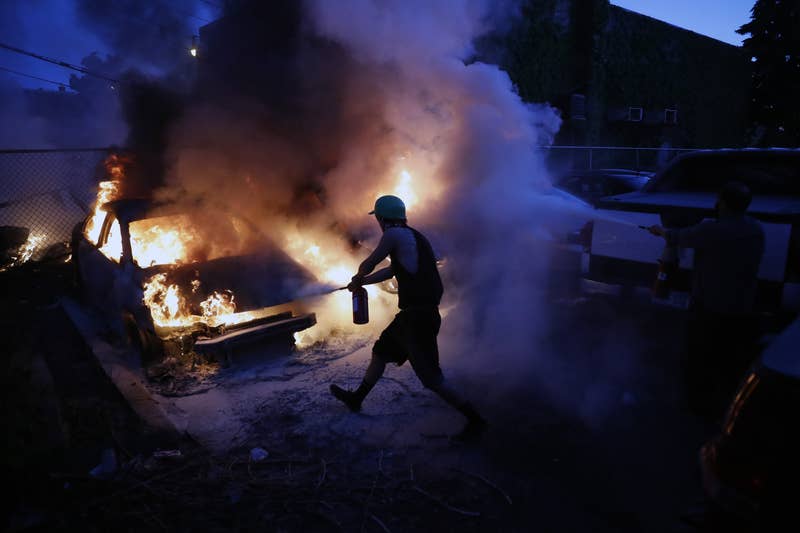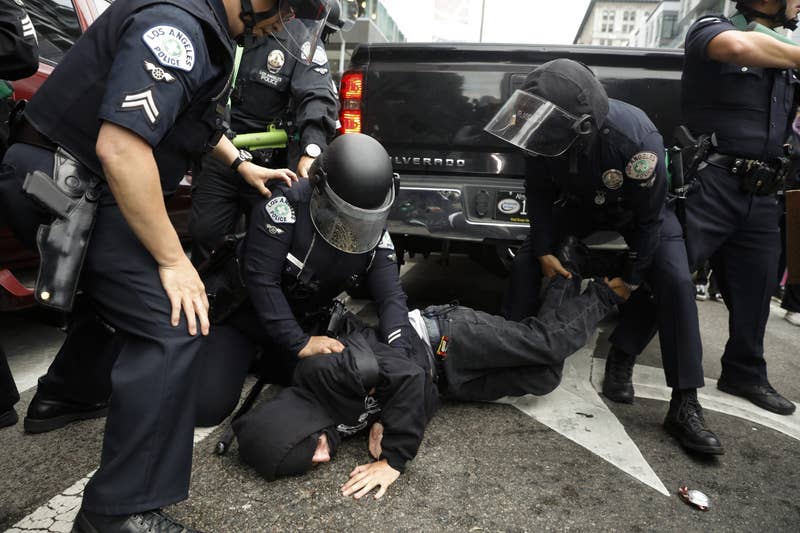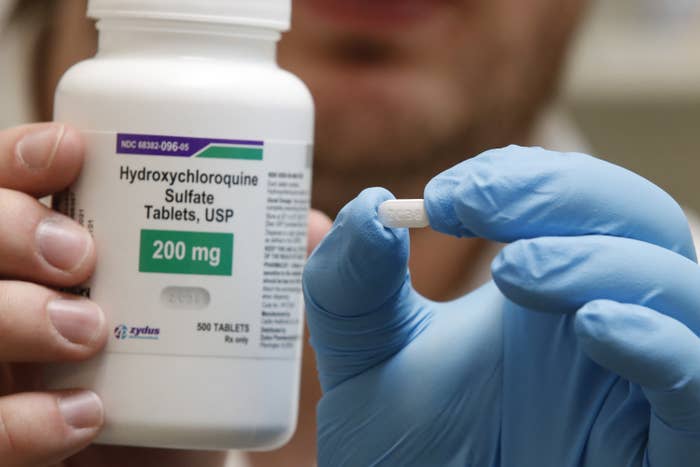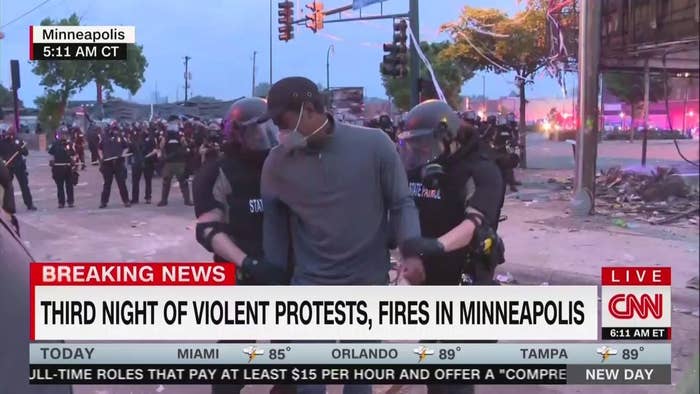The Protests Against George Floyd's Death Make Some People Uncomfortable. That's The Point.
As responses to the protests over George Floyd’s death come in, it’s clear that only some people are allowed to agitate in public without any consequences.
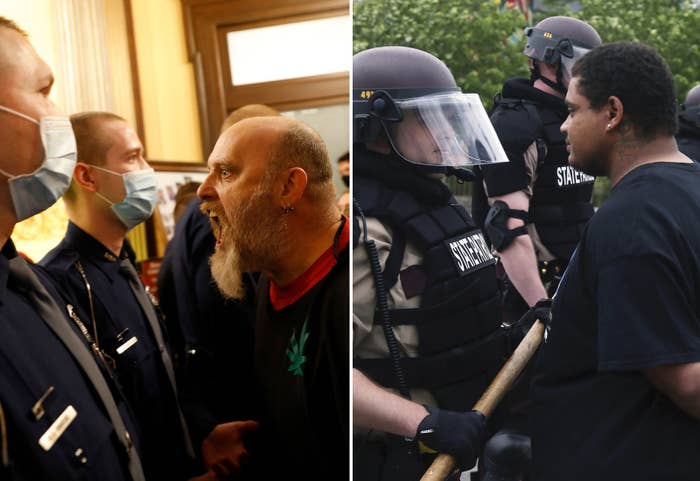
Getty Images, AP / Jim Mone
Left: Protesters confront police at the Michigan House of Representatives chamber after protesting for the reopening of businesses in Lansing, Michigan, April 30. Right: A protester stands face-to-face with a Minnesota state trooper on May 29 after another night of demonstrations over the death of George Floyd, who died in police custody Monday in Minneapolis.
Consider the following questions a kind of Myers-Briggs personality test for how you feel about protests. What bothers you more: images of armed white protesters storming the Michigan State Capitol and screaming at police in late April, demanding the state reopen so they can exercise their rights to possibly contract the coronavirus, or images of demonstrators setting buildings on fire in Minneapolis while protesting the death of a black man named George Floyd, who died while in police custody?
The Michigan protesters were armed with assault rifles and bulletproof vests; no national guard was dispatched there. Meanwhile, the Minneapolis protesters were demanding criminal charges for Derek Chauvin, the police officer who crushed Floyd’s neck with his knee for eight minutes as Floyd gasped for air, the same officer who had 17 complaints against him throughout his career, all closed without disciplinary measures, except one. (Chauvin was finally arrested and charged with murder this morning.)
This is a unique time for protest in America. Black Americans are still demanding that their government and police forces do something about police brutality against black people and the general spate of violence against unarmed black people. (Ahmaud Arbery was shot and killed by a retired police officer and his son in Georgia in January, and the perpetrators have only now been arrested and charged with murder after video leaked.) But black Americans are also grappling with a pandemic that’s disproportionately affecting them. And yet, despite this outsize risk, many black people still took to the streets across the country to protest the killings of Floyd and Breonna Taylor, a black EMT worker who was shot by police in her own home in Kentucky.
The police killings and the coronavirus’s impact are galling enough, but it’s only made worse by the dialogue around the protests and riots happening now. “If you loot riot and destroy you lose all moral credibility, in my eyes, to protest injustice,” tweeted conservative activist Charlie Kirk on Wednesday. “Our country allows for peaceful protests, but there is no reason for violence,” first lady Melania Trump tweeted today.
On Twitter, Tracy Clayton offered up a long list of why white people riot, including their sports team winning, their sports team losing, wanting dolls, hating disco, and being mad that black people wanted to go to school. Meanwhile the president tweeted early this morning that looters should be shot, invoking a phrase first used by Walter Headley, a Miami police chief from the late ’60s who used violent tactics against black protesters in Miami at the time. (Trump has since tweeted some version of a correction.) There’s a fallacy already being presented, as if people are looting instead of attempting peaceful protests. But what’s happening in Minneapolis, Louisville, Los Angeles, Denver, New York, and other parts of the country is actually a last resort.
The priorities in American life are wildly disordered. First comes white health and safety. Then comes white property and goods. Then white economy. Then white comfort. The safety of black and brown bodies, the right to not be killed by the police when you’re not a threat, the right to not be pepper-sprayed or teargassed while a respiratory disease is already ripping through your community at an alarming rate, is miles behind white comfort.
What did the president call the armed Michigan protesters? “Very good people.” What did he call the Minnesotan protesters, demanding justice for Floyd? “THUGS.”
If you’re exhausted, it’s because you’re paying attention. This isn’t the first or the last time we’ll debate what the right way for black and brown people to protest is. It’s already been made clear that peaceful protests draw an incredible amount of ire too — in 2016, 49ers quarterback Colin Kaepernick knelt during the national anthem to protest deaths like Floyd’s. At an Indianapolis Colts game in 2017, Vice President Mike Pence stormed out of the game soon after arriving because some of the players kneeled during the national anthem; in this case, this peaceful protest was still too much for the government to tolerate. Protesting peacefully — without disturbing property and buildings or hurting anyone — has still become a major touchstone of the American culture wars anyway. Years later, Kaepernick is still effectively shut out from the NFL.
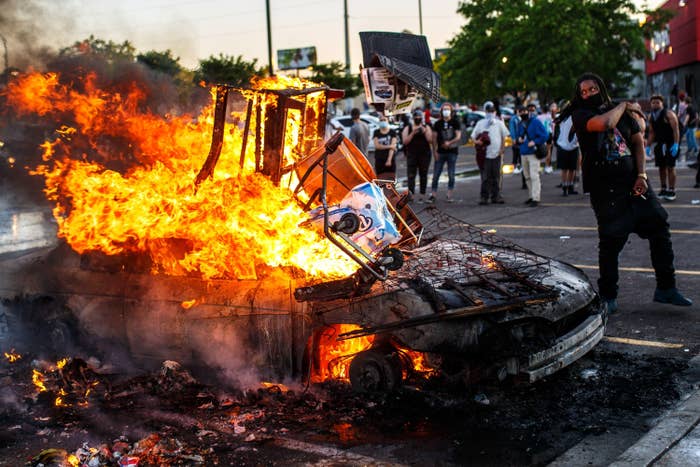
Kerem Yucel / Getty Images
Protesters throw objects into a fire outside a Target store near the Third Police Precinct station in Minneapolis during a demonstration over the death of George Floyd, May 28.
If kneeling is too disruptive for white comfort, then how can any black person make clear their fury at a broken system and a country that still doesn’t care about their lives? If a black reporter gets arrested on camera when he’s clearly just there doing his job, what hope is there for anyone else who doesn’t have the privilege of CNN backing them when the police arrest them?
If kneeling is too disruptive for white comfort, then how can any black person make clear their fury at a broken system and a country that still doesn’t care about their lives?
No one is advocating that burning down an AutoZone be the first resort of protesters asking for racial justice. Fires and looting are rarely the first resort for anyone. But for all the hand-wringing over destruction at a Target store, there wasn’t nearly as much about Target, a company worth billions, not providing its outsourced employees with appropriate PPE. In fact, their employees were part of a mass “sickout” protest organized for May 1, demanding the company do more to protect their essential workers. And there’s been little accounting for the actual small businesses in the area affected by the rioting, which have likely also been severely affected by COVID shutdowns. Meanwhile, the owners of the restaurant Gandhi Mahal in South Minneapolis posted on Facebook in support of the protests despite their business catching on fire. “Let my building burn,” they wrote. “Justice needs to be served, put those officers in jail.”
So what have we learned? Not much that we didn’t know before. We already knew that white people getting arrested at a protest will look like a woman being handled respectfully by police sans riot gear, while black demonstrators are faced with police officers wearing riot gear and gas masks, and brandishing weapons.
And it’s no mistake that white people protesting with guns over the right to reopen have been received differently by the federal government and conservative talking heads — people who are routinely unable to recognize the privilege they have when dealing with police — than when black people protest for the right to live. The comfort of white people has always come before the safety and survival of black people. As New York Times reporter Nikole Hannah-Jones explained in a Twitter thread, “The fact of history is non-violent protest has not been successful for blk Americans.” Martin Luther King Jr. himself once said: “A riot is the language of the unheard.” These protests are not coming out of a vacuum. Rather, it’s more of the same: a history of black humanity being put last, always. ●

